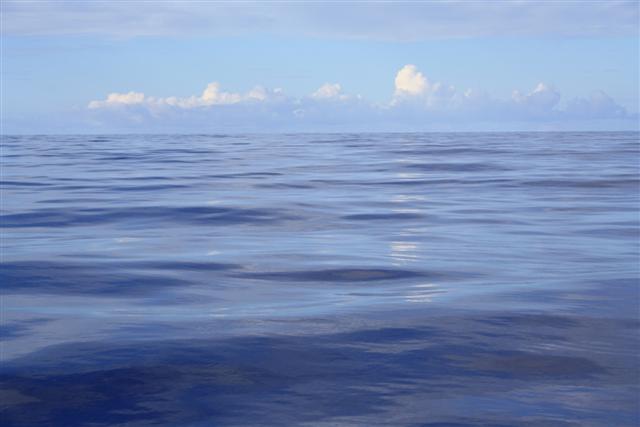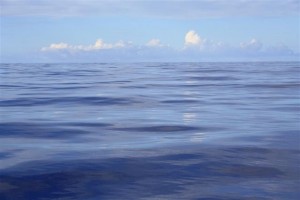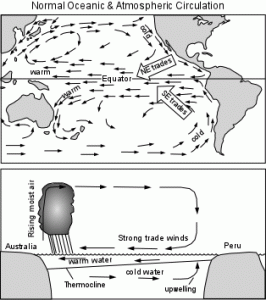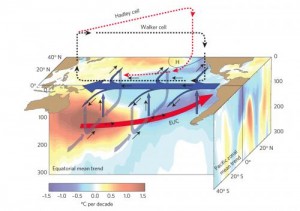February 10, 2014 – This headline quote comes from Dr. Steve Rintoul, of CSIRO, the Commonwealth Scientific and Industrial Research Organisation, Australia’s national science agency. Rintoul is a leading authority on the circulation of the Southern Ocean. He makes this statement in support of a new study that explains why global warming does not trend continuously but moves instead in fits and starts.
In a report appearing in Nature Climate Change, scientists describe why global warming has slowed down in the last 12 years and why this is a temporary aberration. The halt is explained by acceleration of the equatorial trade winds blowing from Pacific coast of the Americas to the Western Pacific. These winds have impacted ocean circulation leading to the subduction of warmer surface water into the ocean depths. This has virtually halted the steady rise in atmospheric temperatures over the Pacific and has impacted the rest of the world as well.
In the diagram below we can see the normal pattern of the Pacific both in the atmosphere and ocean. Note in the bottom illustration how strengthened trade winds impact the distribution of warm water from Peru to Australia as the winds push ocean circulation to the west.
But the research report also shows a similar pattern in the history of wind and ocean circulation over the Pacific. Back between 1940 and 1975, a similar stall occurred in global temperatures linked to increased wind activity over the Pacific and leading to cooler than expected atmospheric temperatures.
So are the climate change deniers right? Is all this talk about increased CO2 pure nonsense? No state the scientists in this study. They argue that the hiatus in warming will end when the trade winds resume their normal pattern. At that point much of the suppressed heat in the ocean will rise to the surface and enter the atmosphere creating a new pulse of warming. They believe that this will lead to even more exaggerated warming. In the diagram below we can see the trends in temperature and ocean and atmospheric circulation over the Pacific Ocean during the past two decades. Colored shading shows observed temperature trends.
The scientists have described the surging trade winds as unprecedented and well beyond the expectations of existing climate models. They suspect these winds will continue to persist until around 2020 when they will abate. At that point rapid warming will occur. This does not bode well for Australia, already suffering from higher temperatures and severe drought despite the fact that much of the rest of the inhabited world has been spared. Of course even though the upward climb in average temperatures has halted, the Arctic continues to melt at an unprecedented level and the Antarctic peninsula continues to see thinning of its coastal ice shelves.





















